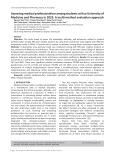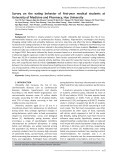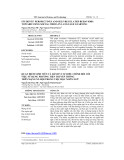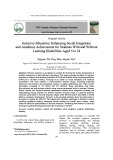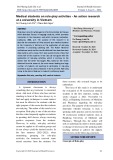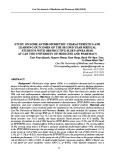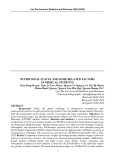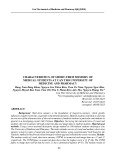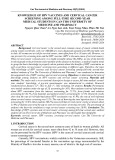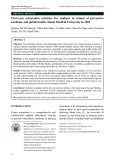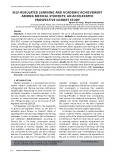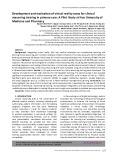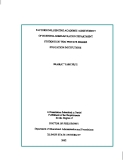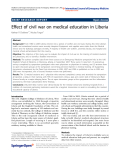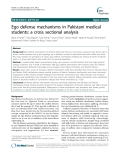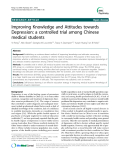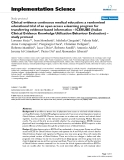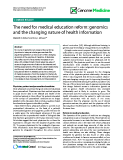
22
Journal of Medicine and Pharmacy, Volume 9, No.3/2019
SELF-REGULATED LEARNING AND ACADEMIC ACHIEVEMENT
AMONG MEDICAL STUDENTS: AN ACCELERATED
PROSPECTIVE COHORT STUDY
Nguyen Van Hung1, Wongsa Laohasiriwong2
(1) Faculty of Public Health, Hue University of Medicine and Pharmacy, Hue University, Vietnam
(2) Faculty of Public Health, Khon Kaen University, Thailand. Board Committee of Research and Training Centre for
Enhancing Quality of Life of Working Age People (REQW), Khon Kaen Univeristy, Thailand
Abstract
Objectives: To determine the relationships between the use of self-regulated learning strategies and
academic achievement among Vietnamese medical students. Methods: An accelerated prospective cohort
study among 623 students at a public medical university, Vietnam was conducted during the academic year
2012-2013. Fourteen self-regulated learning subscales including intrinsic/extrinsic goal orientation, task
values, self-efficacy for learning, control of learning beliefs, rehearsal, elaboration, organization, critical
thinking, meta-cognitive strategies, time and study environment, effort regulation, peer learning, and help
seeking were measured using the Motivated Strategies for Learning Questionnaire. The Grade Point Average
was recorded through two consecutive semesters of the academic year 2012-2013. Data were collected
at two points in time (once each semester). Generalized Estimating Equation was applied to explore any
relationships between the use of self-regulated learning subscales and Grade Point Average, adjusting for
the effects of within cluster correlation, National Medical Admission Test scores, and times of measurement,
depression, anxiety, stress, and demographic covariates. Results: Results from multivariate analysis revealed
that extrinsic goal orientation, time and study environment, and effort regulation were found to be significantly
positively associated with Grade Point Average (mean difference: 0.932; 95%CI: 0.344 to 1.528). Conclusions:
The use of self-regulated learning strategies can be helpful for improving of academic achievement among
Vietnamese medical students.
Key words: self-regulated learning, academic achievement, medical students, Vietnam
Corresponding author: Nguyen Van Hung, email: drhhung@gmail.com DOI: 10.34071/jmp.2019.3.4
Received: 12/3/2018, Resived: 2/5/2019; Accepted: 10/6/2019
1. INTRODUCTION
Medical education is a developmental process
toward medical professional life that demands
self-regulated and life-long learning proficiencies
[1][2][3][4][5]. Responding to these demands, the
worldwide innovation in medical education, in the
last two decades, has been shifting from teacher-
centered to student-centered approaches [3][6].
This shifting has given rise to the concept of Self-
Regulated Learning [2][6][7].
Self-Regulated Learning (SRL) is the application
of general self-regulation theory to the field of
education which focuses on students’ ability of
regulating their own learning strategies and learning
motivation in order to optimize their achievement
and satisfaction [8][9][10][11][12]. According to
Pintrich, SRL is “an active, constructive process
whereby learners set goals for their learning and
then attempt to monitor, regulate, and control
their cognition, motivation, and behaviors, guided
and constrained by their goals and the contextual
features of environment” (Pintrich, 2010, pp 453).
By possessing a high level of cognitive and meta-
cognitive strategies, learning motivation and
resources management, SRL learners tend to surpass
their counterparts in improving their academic
achievement [12][13] and clinical competency [14]
[15]. In addition, they are also better in coping with
learning difficulties or failures that, consequently,
may improve their academic achievement [16][17]
[18][19], and mental health[20]. However, recent
SRL studies mostly focus on the field of general
education whereas medical education as a distinctive
field of education has been largely neglected [6].
In Vietnam, the innovation in medical education
toward student-centered approaches has been a
priority policy of the Ministry of Education & Training
and Ministry of Health for more than ten years aims
at improving students’ academic achievement and
independent lifelong learning proficiency [21].
However, student’s passivity in learning is still a big
challenge for medical schools [22]. Although, much
attention have been paid in attempting to improve
students’ SRL capacity; however, the application of
SRL and its relation to their academic achievement





